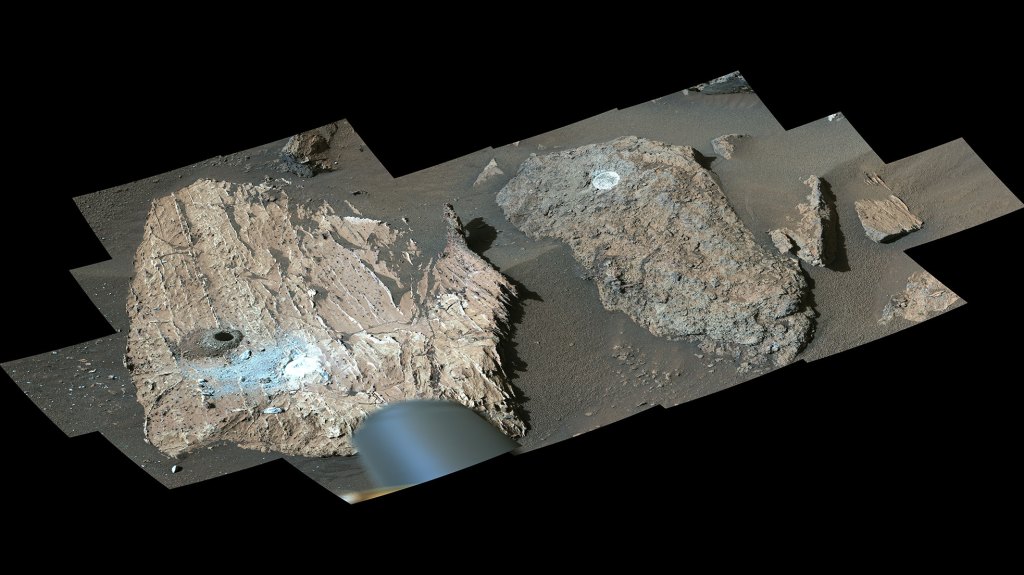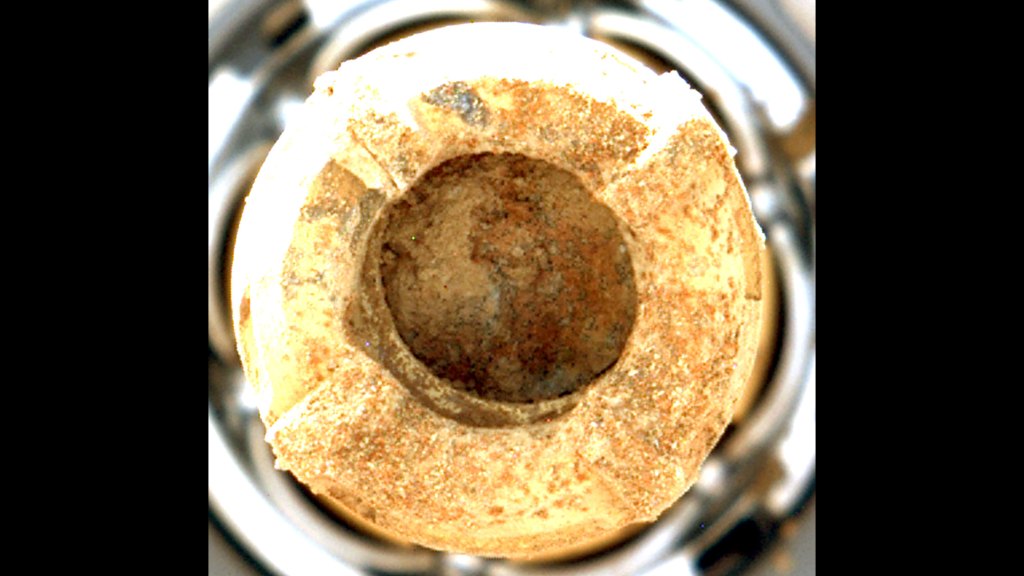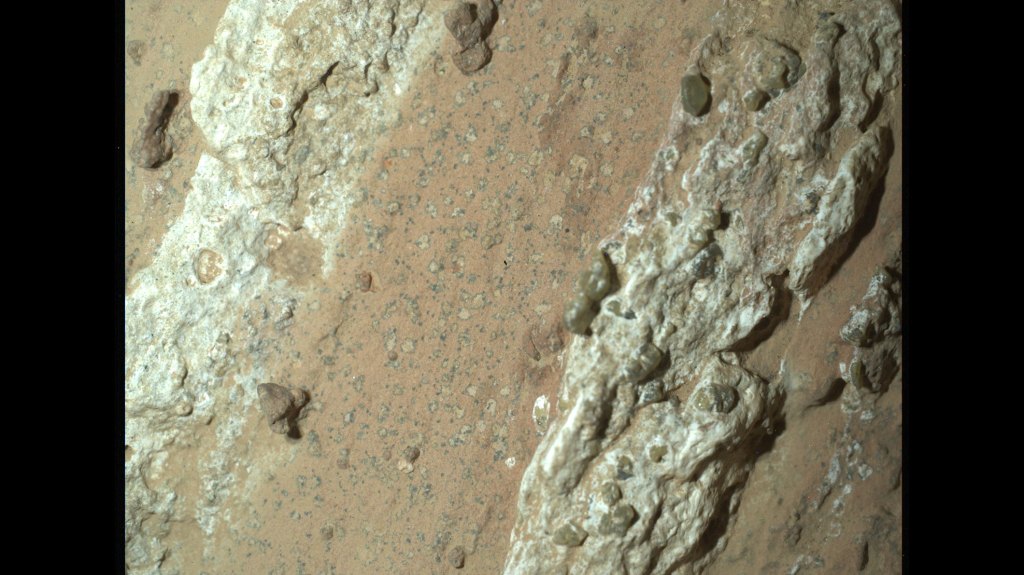NASA’s Perseverance rover discovered “leopard spots” on a reddish rock nicknamed “Cheyava Falls” in Mars’ Jezero Crater in July 2024. Scientists think the spots may indicate that, billions of years ago, chemical reactions in this rock they could have supported microbial life; other explanations are being considered.
NASA/JPL-Caltech/MSSS

An annotated version of the Cheyava Falls image shows leopard-spot-like markings, which have particularly fascinated scientists, and olivine in the rock. The image was captured by the WATSON instrument on NASA’s Mars Perseverance rover on July 18.
NASA/JPL-Caltech/MSSS
The six-wheeled geologist found a fascinating rock that has some indications that it may have had microbial life billions of years ago, but further research is needed.
A vein-filled rock is catching the eye of NASA’s Perseverance rover science team. Nicknamed “Cheyava Falls” by the team, the arrowhead-shaped rock contains fascinating features that may be related to the question of whether Mars was home to microscopic life in the distant past.
Analysis by instruments on board the rover shows that the rock possesses qualities that fit the definition of a possible indicator of ancient life. The rock exhibits signatures and chemical structures that could have possibly been formed by life billions of years ago, when the area being explored by the rover contained flowing water. Other explanations for the observed features are being considered by the science team, and further research steps will be required to determine whether ancient life is a valid explanation.
The rock — the rover’s 22nd rock core sample — was collected July 21 as the rover explored the northern edge of Neretva Vallis, an ancient river valley a quarter-mile (400 meters) wide that was carved by water that flowed into the Jezero crater. a lot of time ahead of time.

“Cheyava Falls” (left) shows the dark hole where NASA’s Persistence took a core sample; the white spot is where the rover scraped away at the rock to probe its composition. A rock nicknamed “Steamboat Mountain” (right) also shows an erosional patch. This image was taken by Mastcam-Z on July 23.
NASA/JPL-Caltech/ASU/MSSS

NASA’s Persistence used its Mastcam-Z instrument to view the Cheyava Falls rock sample inside the rover’s bore. Scientists believe the markings on the rock contain fascinating features that could be linked to the question of whether Mars was home to microscopic life in the distant past.
NASA/JPL-Caltech/ASU/MSSS
“We designed the path for the Persistence to ensure that it goes to areas with the potential for interesting science samples,” said Nicola Fox, associate administrator, Science Mission Directorate at NASA headquarters in Washington. “This trip across the Neretva Vallis riverbed paid off as we found something we had never seen before, which will give our scientists so much to study.”
Multiple scans of Cheyava Falls by the rover’s SHERLOC (Scanning of Habitable Environments with Raman & Luminescence for Organics and Chemicals) instrument show that it contains organic compounds. While such carbon-based molecules are considered the building blocks of life, they can also be formed by non-biological processes.
“Uvara Cheyava is the most strange, complex and potentially important rock yet investigated by Perseverance,” said Ken Farley, Caltech’s Perseverance project scientist in Pasadena. “On the one hand, we have our first convincing discovery of organic material, distinct colorful stains that show chemical reactions that microbial life can use as an energy source, and clear evidence that water – necessary for life – once flowed through the rock. On the other hand, we have not been able to determine exactly how the rock was formed and to what extent nearby rocks may have heated Cheyava Falls and contributed to these features.”

NASA’s Perseverance rover used its Mastcam-Z instrument to capture this 360-degree panorama of a region on Mars called “Bright Angel,” where an ancient river flowed billions of years ago. Cheyava Falls was discovered in the area just to the right of center, about 361 feet (110 meters) from the rover.
NASA/JPL-Caltech/ASU/MSSS
Other details about the rock, which measures 3.2 feet by 2 feet (1 meter by 0.6 meters) and was named after a Grand Canyon waterfall, have also intrigued the team.
How rocks get their points
In its search for signs of ancient microbial life, the Perseverance mission has focused on rocks that may have been created or modified long ago by the presence of water. That’s why the team settled in Cheyava Falls.
“This is the kind of key observation that SHERLOC was built for – to look for organic matter as it is an essential component of a search for past life,” said SHERLOC principal investigator Kevin Hand of NASA’s Jet Propulsion Laboratory in Southern California, which manages the mission.
Along the length of the rock are large white veins of calcium sulfate. Between these veins are bands of material whose reddish color suggests the presence of hematite, one of the minerals that gives Mars its rusty hue.
When Perseverance took a closer look at these red areas, he found dozens of irregularly shaped, millimeter-sized white spots, each surrounded by black material, similar to leopard spots. Perseverance’s PIXL (Planetary X-ray Lithochemistry Instrument) has determined that these black halos contain iron and phosphate.

/Public Notice. This material from the original organization/author(s) may be current in nature and edited for clarity, style and length. Mirage.News does not take institutional positions or sides and all views, opinions and conclusions expressed herein are solely those of the author(s). Watch it in full here.
